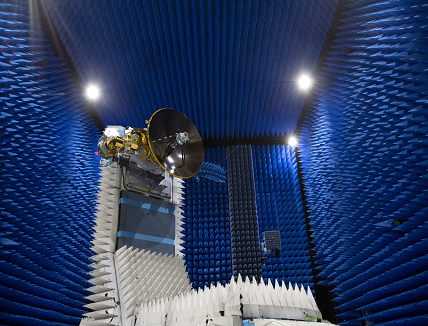
The mission, to be launched in 2022, will study dark energy and dark matter to help understand the origin of the accelerating expansion of the Universe
Thales Alenia Space, a joint venture between Thales (67%) and Leonardo (33%), has delivered the K-band high gain antenna to be integrated with the rest of the Euclid satellite in its plant in Turin. Thales Alenia Space in Spain is responsible for the deep space communications system, which comprises the communications panel delivered in 2019 and the high gain antenna, built by Thales Alenia Space in Rome. Thales Alenia Space in Italy is the satellite prime contractor of the Euclid mission and also responsible for the service module while Airbus in France as main industrial partner is developing the instrument.
Euclid, an astronomy and astrophysics mission of the European Space Agency (ESA) scheduled for launch in 2022 on a Soyuz rocket from Europe’s Spaceport in French Guiana, will survey the sky with a 1.2 m diameter space telescope to explore dark energy and dark matter and understand the origin of the accelerating expansion of the Universe.
Euclid will map the general structure of the Universe over 10 billion light years to show its expansion and growth during the last three-quarters of its history. The mission is designed to address two of the most important questions in cosmology today: How did the Universe originate and why is it expanding at an accelerating rate, rather than slowing down due to the gravitational attraction of its constituent matter?
The contract for the development of Euclid’s communications system has been one of the largest contracts of the company in its 30 years of activity in Spain. Eduardo Bellido, CEO of Thales Alenia Space in Spain, said: “The high gain antenna completes the delivery of the communications system in this important mission, one of the flagship programs of the European Space Agency, which will help us improve our understanding of the Universe. A milestone of which we are very proud and that consolidates Thales Alenia Space in Spain as a European reference in space communication systems.”
Communicating at 1.5 million kilometers
Euclid will map the 3D distribution of up to two billion galaxies and associated dark matter during a six-year mission, covering most of the observable sky outside our Milky Way. The complete survey consists of 150 thousands high definition images with associated colour and spectral information, resulting in close to a petabyte of data to be downlinked. This huge amount of data will be transmitted by the satellite from its orbit around the L2 Sun-Earth Lagrangian point at a distance of 1.5 million kilometers from the Earth, using its K-band (26 GHz) radiofrequency data transmission system to the ESA’s 35m deep space stations located in Cebreros, Spain, and Malargüe, Argentina. Euclid also incorporates an X-band system to control and monitor the spacecraft, and measure its distance to Earth.

Thales Alenia Space in Spain is specialized in satellite communications, building on a long heritage in TT&C and data transmission systems for all type of space missions, including missions in low Earth orbit, geostationary orbit, lunar orbit (Smart-1, KPLO, ESPRIT), the Moon’s surface (VIPER, NOVA-C), science missions orbiting around the L2 Lagrangian point (Herschel, Planck, Euclid, WFIRST, PLATO) and missions to asteroids (HERA).
The Euclid K-band deployable and steerable high gain antenna draws on Thales Alenia Space in Italy’s unique expertise in this domain in exploration missions to the Solar System, like Cassini-Huygens (Saturn), BepiColombo (Mercury) and ExoMars (Mars).
Thales Alenia Space in Italy has also provided the X-band Transponder, while the X-band and K-band Traveling Wave Tube Amplifiers (TWTA) have been developed by Thales Alenia Space in Belgium.
The Service Module and the Payload Module are currently under their final integration tests, respectively in Thales Alenia Space in Turin and in Airbus in Toulouse.
After the mating of the 2 modules and the large Sunshield Solar array, expected in Thales Alenia Space in Turin in the third quarter of 2021, the full flight model spacecraft will be subjected to the environmental test campaign, paving the way to its launch.



















